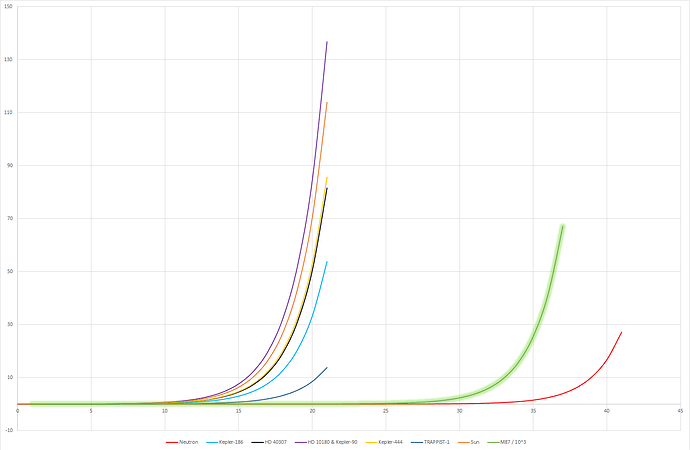This is highly interesting, but where does gravity come into play, as we know gravity affects time relativity?
Gravity, or rather, the effect of mass, that is, the density of a size of an object, has an impact on space. Space is an object. Just one that we dismiss accounting for as an object in our daily lives.
Objects are influenced by the shap of space…in much the same way as a bubble is influenced by the shape of water it moves through.
We summarize this affect as gravity.
Time as a function is therefore affected by consequence of an object’s sequence of positions being affected by this topological impact.
Think of it this way.
If I told you that it would take more time to travel the same distance uphill than downhill for a rolling ball, you wouldn’t think much of it. It’s somewhat like that.
Cheers,
Jayson
That’s arguably the best analogy I’ve ever heard for how time is affected. Thanks Jayson! Props as always, I hope you dont mind me totally picking your brain over this. I’ve never had the pleasure to talk with you and other people in this thread that are totally absorbed in the cosmos.
Best thread on IDMf? I think so ![]()
Absolutely willing at any time! ![]()
And actually, I just realized that analogy is a bit shortsighted.
A more full and proper analogy to hit your brain the right way would be to say…
If I told you that it would take more time to travel the same distance uphill than downhill for a rolling ball, you wouldn’t think much of it. You would intuitively understand that the ball met resistance going uphill and therefore the reference frame from one position to the next was a slow rate of change for the atoms and particles involved in regards to their motion of position as a collective, and that the opposite was true regarding going downhill.
You also wouldn’t think it was shocking if I said that a person hanging onto the wing of a plane could move less per moment than a if they were attempting to move on the ground.
Nor would you find it remarkable if I told you that if I put a person into an impressive pressure chamber, they would have difficulty moving at an equal rate of motion as in a less pressured area.
The issue involved in each of these is pressure, more than anything.
One analogy that I really love to use is this…I might be getting carried away, but anyway…
Forget the universe for a moment. There is only a blob of gel.
The universe is this blob of gel. There is nothing in the universe that isn’t this blob of gelatin.
Now, this blob of gel isn’t motionless. There’s slight activity in it because it expands and contracts, and this creates currents of gel motion inside of it in much the same way that the ocean expanding and contracting over vast distances creates currents, even if temperature wasn’t a consideration, but temperature is a consideration even without the Sun or stars or weather because motion itself generates a less than 0 Kelvin temperature. So the gel itself isn’t at exactly 0 Kelvin in a reference frame. It’s nearly 0 Kelvin (aka 0 motion), but not exactly, and that “not exactly” is all the wiggle room we need here.
Sometimes those currents, no matter how small they are, make their way to rubbing against each other or colliding with each other, no matter how feint, and once in a while this causes a bit of the gel to move around in a spot, obviously, but just like sometimes two currents in water can generate an underwater eddy, a bit of water that twists and spins, these currents can cause a bit of gel to twist up upon itself just a bit.
Now that twist of gel has a greater density than the gel around it. Now if a bit more gel nearby gets twisted up into a greater density than the gel around it, and the gel universe continues to have reverberating motion - which it does - then those two gel twists can get near each other and get moving through the gel - like that twist of water that is an eddy moving through water…it’s just water in water, but the form of that eddy makes all of the difference and makes it different from the gaussian form of water around it.
Once one gets near the other, the more dense of the two wins the ownership of affecting the spacial gel, that is the gaussian gel that isn’t twisted up into dense packets. Now if the size of these gel twists are tiny, then the force of the gaussian gel space’s “currents” of motion, which is small remember…really small…really, really, really small, then nothing’s going to happen - because of the same idea as that twisted eddy not having any ability to influence the ocean water if the ocean water current is a bigger force of mass collectively than the twisted eddy. However, if those twisted pieces of gel are of size in density that is greater than the forces of the currents of the guassian gel movement, then when one twisted bit of gel in the gel universe gets near another twisted gel, then the one that is able to more greatly affect the guassian gel space around it will be the one that appears to have a controlling force over the other twisted bit of gel. The ease of moving through a location in the gel universe, therefore, is defined (not counting an object’s velocity) by the density of the space in which the gel object (which is just a twisted up bit of the gel universe) is moving through.
It takes a moment to picture all of this, but once you can run this simulation in your imagination, and realize that the universe is ultimately just an array of itself twisted up and that nothing is fundamentally made of anything other than the same thing that space is made of, then a lot of the “wtf” confusions fly right out the door. For instance, consider for a moment that when you split a photon, you get a byproduct of an electron and a positron, and that an electron “spins” in one direction, and the positron “spins” in the opposite direction…sort of like a current of water hitting a rock and an eddy forming on each side of the rock and spinning in opposite directions. Now, the question is…is the eddy on the left a separate object from the eddy on the right? Are either a separate object from the current that hit the rock? And is the current any different from the water it rode through?
![]()
Cheers,
Jayson
This is a good thread seriously
This is quite exciting ![]()
On that note - I ran M87 through the Phi process (described in my paper previously) and interestingly it can still be quantified by the same method, though the value of the exponent is closer to the exponent used for Neutron Star systems (Phi^30 to 40) than for regular Star Systems (Phi^21).
It may be that high energy systems have a higher return on their system core radius in the Phi sequence.
M87 in glowing green (has been scaled down in lightyears by 10^3 magnitude or else it wouldn’t even fit on the chart - so 67 lightyears where it ends is really 67,000 lightyears for the radius of the galaxy).
Only M87 is in terms of lightyears. All others are in terms of AU (astronomical units).
Cheers,
Jayson
We are all actually star dust

![]()
Cheers,
Jayson
So this video blew my feeble little mind last night:
Previously, my knowledge on the subject stopped somewhere around the time when all the stars eventually turn into white dwarfs/neutron stars/black holes without new ones being born again and everything being really far from everything else due to the ever increasing rate of expansion. But this fucking video kept going for 25 more minutes after that point, as the time sped up exponentially, and soon enough it became kind of difficult to breathe…
Bump because science is impornant
That video may speculate about the end of the Universe and its components but it still leaves unanswered questions. We are on the verge of metaphysics with such speculations. The question arises: what will follow the end of the Universe? Will another Universe emerge from the darkness, spawned from the energy in that "dark matter? In deep occult literature there is talk of periods of “Pralaya” and then the emergence of another Cosmos, although the periods of time hinted at are incredibly vast beyond human conception.
My understanding is that the current expectation is that all stars will die and form or be swallowed by black holes, which will just be whizzing around in empty space, occasionally colliding with one another. Eventually, it goes one of two ways.
-
The universe continues to expand infinitely in which case nothing ever happens again once black holes have consumed all matter. The black holes become increasingly isolated from each other as the distance between them grows at such an increasing rate that even any radio signals they emit at the speed of light on our side of the event horizon won’t be fast enough to ever reach another black hole. They eventually decay via hawking radiation, but the particles they emit this way are created so slowly and are being sent into such a large empty universe that they are unlikely to ever interact with another particle (and it eventually becomes impossible for them to do so). At the end you have essentially an empty universe. If the universe continues to expand still, it eventually rips even these particles into even more basic particles, and those into more basic particles. If that continues, you eventually get to the point where you just quantize the particles out of existence. All of this takes so long that a physicist does not have a problem with just saying “forever”.
-
The universe does not expand infinitely, in which case black holes still have their day and consume all matter. However, in this scenario the force of gravity is able to overcome dark matter (which drives the expansion of the universe) and bring those black holes together. Depending on how exactly this plays out, it still takes a very long time. Physicists still are fine with calling this “forever”, though it’s not as long a forever as in scenario 1 by a few thousand orders of magnitude. In the end, all matter collapses to a single point and likely we have another big bang (or so my lousy youtube education would suggest).
Well this is interesting.
Stuck is the wrong word.
The correct statement is that water bears now inhabit the moon. ![]()
Cheers,
Jayson
.
.
.
.
They are the Nac Mac Feegles of reality!
This is all pretty cool by me. I don’t get why we’re supposed to preserve planets when one of the primary motivations to go to them is ultimately capitalist plunder like we did to the Americas. I can see preserving parts of them for future study and the sake of preservation (like national parks here on earth) but I’m never going to feel as strongly about other planets as I can about earth. Once we’re planet hopping, it actually gets really hard for my businessman brain to not see planets as disposable caches of resources.
Also is it just me or do those look like the advisors from Half Life 2 Episode 2?
Hey @Jayson I didn’t know you had your own soda brand.
lol
Outstanding!
Cheers,
Jayson
We are living in the past because the light from other stars and galaxies takes a while to travel to us so what we currently witness happening a few billion trillion octillion miles away already happened x amount of years ago so if we ever happen to travel to those locations any of data that we currently have would be seriously outdated, that and there is a possibility that our current physics might not be the universal standard
Over the next ( insert unknown long length of time here ), I’ll be taking my first project to the next stage.
My first project was cataloging astrosphere radii estimates made by research teams (my second project was an accidental product of this and explored using phi in estimating exoplanet semimajor axes).
Why?
Because half a decade ago, I had a question, went to look it up, found that I couldn’t do that so easily because the data was scattered like shrapnel from a grenade all over the place.
It involved astrosphere sizes - my question back then.
What I bumped into learning was that there’s no single model for estimating astrosphere radii, no catalog of everyone’s estimates, nor of the models, nor any index anywhere of the various models or papers done by who, when, and what methods were used.
There’s the exoplanet catalog and the SIMBAD catalog, which give you tons of data on exoplanets and stars, but neither say a peep about astrospheres.
It gets worse. When I started to learn and teach myself the needed astrophysics, I wanted to reach out to professors and researchers who had an expertice in this area.
I found one.
Let me say that again. I found one.
A professor in India.
NASA didn’t have one. They had a fellow who was specialized in stellar winds (photon emissions from stars), which is tightly related and he was super helpful in checking my practices with standard stellar wind equations and pointing my way to lessons. But he wasn’t on the dig for astrospheres.
I spent a ton of time working with the professor from India. He was very, very helpful in course-correcting my progress.
But yeah…it was a ghost town. It still is.
Which makes the lack of centralized data on the matter that much more shocking. Usually small niche fields have researchers who all know each other and you see the same names popping up in references, blogs, articles, etc…
Nothing. Papers are written mostly entirely ignorant of each other. Everyone is going about their work in isolation.
I created a way of meaningfully cataloging the estimates and models since no one agreed. There needed to be a baseline for comparing them against each other rather than just a pile of unrelated estimates with zero conceptual context.
So I did that. But it was just on my computer locally.
Pretty useless.
I’ve finally now got an angle on how to move the project online as an eventual interactive graphical database.
I’m going to build it with Python, MySQL, and Flask.
To start with, I’m going to host it off of pythonanywhere.com.
It’ll develop in stages and modules; starting with getting the raw database up first, basic index data returning web interface second, visual graph chart third, visual model profile fourth, interactivity last.
It’ll be a long, long road, but at least now I know what the road looks like!
Cheers,
Jayson

